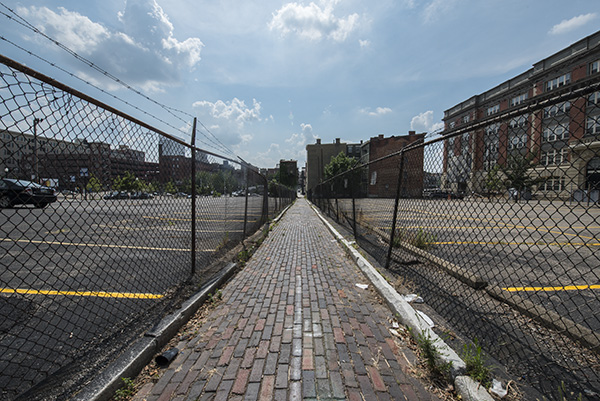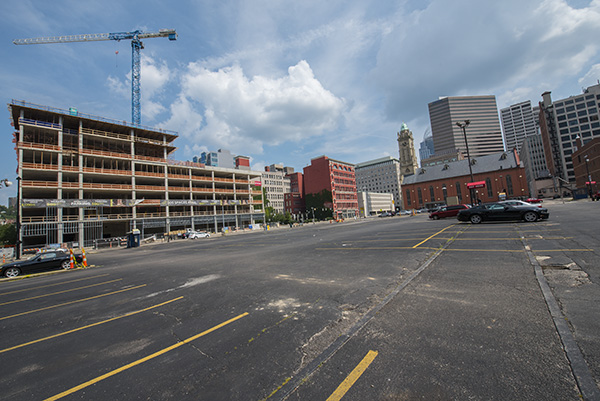Soapdish: A paving paradise in Cincinnati’s urban core
Fun fact: Downtown surface parking lots silently suck the life out of everything good about our city's urban renaissance while making their rich owners even richer!
With the onslaught of a sweltering Cincinnati summer in full force and effect, what better escape is there from late July heat and humidity than a Soapdish screed on the inherently sexy topic of surface parking lots? To paraphrase the old Calgon commercials: Concrete, take me away!
Yes, it’s time for an ode to those charming pock-marked swamps of crumbling asphalt scattered about our urban core, surely and silently sucking the life out of everything that exists around them.
Employing few if any citizens, requiring little in the way of capital investment and possessing no accoutrements other than perhaps a modest tar-papered shack and some concrete logs, parking lots provide a steady stream of income to wealthy owners. Giant cash- and life-inhaling parcels of blight in the middle of our city, they simply sit there and exist with all the charm of a demolished building — the foundations of which support many, if not all, of the lots.
“Surface parking lots are holes in the urban fabric,” says Donald Shoup, a professor of urban planning at UCLA and noted urban parking panjandrum. “They don’t produce as much for the economy. The parking lot barely employs a few people compared to a restaurant. A parking lot doesn’t draw anybody to downtown.”
In Rethinking a Lot, Eran Ben-Joseph, a professor of urban planning at M.I.T., observes that “in some U.S. cities, parking lots cover more than a third of the land area, becoming the single most salient landscape feature of our built environment.”
According to Ben-Joseph, there are 800 million surface parking spaces in the U.S., translating to an area larger than Puerto Rico. Eight nonresidential parking spaces exist for every passenger car in most urban areas in the U.S., and in some urban areas there are more than 30 spaces per car.
A regrettable byproduct of a transit-deficient city is the thriving trade in surface parking lots, where old buildings are pulled down and graded over while enterprising hucksters wave you in off the street to navigate your soon-to-be-door-dinged car into a sardine can space.
The lots, however, are relatively cheap to build. A surface lot can cost on average $4,500 per space to construct, compared with $22,000 for above-ground structures and $34,000-$45,000 for below-ground. While the capital costs of these surface lots are considerably less than the hundreds of millions required for above- or below-ground parking structures, the aesthetic decimation of our streetscape and pedestrian isolation they engender is an irrefutable blight on our urban core.
Every day I walk or ride, multiple times, on 12th Street east of Sycamore through the desolate “Straits of Pendleton” — a dystopian, concentration camp-like hellscape of undulating asphalt, crumbling pavement, weeds, razor wire and rusted, blown-out cyclone fencing. Also known as the new venue for this year’s MidPoint Music Festival (!), this unrelenting heat sink of parking lots and excessive stormwater runoff sits smack dab in the middle of a thriving historic district, development exploding around it.
Despite redevelopment activity on all sides — Pendleton, Over-the-Rhine, the old SCPA, Ziegler Park — these islands of marginally maintained pavement soldier on silently, all the while providing steady streams of cash to their absentee overlords.
Historic brick alleys such as Grear and Bunker bisect the blocks, pedestrian chutes surrounded on both sides by a charmless fabric of corroded fences and concertina wire. In what should be a walkable pedestrian district in the heart of our urban core, we’re instead greeted by a black hole of parking, harkening back to the days of suburban flight, automobile domination and urban devaluation — when cheap shopping-mall-style parking was offered as a sop to lure fleeing suburbanites back into the scary city.
This scene is replicated throughout the downtown basin, including P&G’s parking farm along Eggleston, Walnut & Central Parkway, Fourth & Plum and the wholesale demolition behind the endangered and historic Dennison Hotel.
Don’t get me wrong: We have it better than a lot of cities. Detroit is a disaster in this regard, and Hartford, Conn. hollowed out its tax base with acres upon acres of surface lots. Even nearby peer cities like Louisville and Indianapolis flattened out large segments of their downtowns to accommodate surface lots, destroying aesthetics and walkability in the process.
Indeed, Streetsblog USA runs a bracket-style tournament every year now dubbed “Parking Madness.” Last year’s winner was Camden, N.J., which joined previous winners Tulsa, Okla. and Rochester, N.Y. in dubious distinction.
In Cincinnati, however, the development of The Banks has allowed us to eliminate acres of surface parking that previously sat on prime riverfront land. Washington Park buried the parking spaces comprising an unsightly lot at Music Hall’s front door and replaced it with an expansive community green. Ziegler Park is burying its spaces and replacing them with a new park and aquatics facility.
By no means are we perfect, though. Change is incremental, and stubborn pockets doggedly hold on (e.g. the aforementioned Dennison dustup).
That said, there must be better uses for the land and better ways to incentivize owners of these blighted craters of lifelessness, many of whom are wealthy and well-connected such as the Chavez (locally owned PCA, one of the largest privately held parking companies in America) and Joseph (suburban automobile magnates and would-be destroyers of the Dennison bloc) families.
I realize that cars aren’t going away, but hasn’t the tide turned at least slightly? Shouldn’t we be looking for ways to erase this sort of blight in our thriving, historically dense urban core?
As our downtowns are being repopulated and younger generations are eschewing (or at least minimizing) the automobile in favor of walkable urban districts, now is the time to develop appropriate policies to best utilize our limited resources and defined spaces. And it’s time to throw out the transportation engineer-dominated 1970s era urban planning manifestos that simply focused on the most efficient way to get cars and people in and out of our urban core as quickly and safely as possible.
The time is ripe to reimagine how we approach parking infrastructure and transportation, both in engineering as well as public policy. And help is on the way.
The Cincinnati Streetcar, an investment in our transportation infrastructure, opens to the public on Sept. 9. The initial 3.6-mile leg will extend from our riverfront parking valhalla at The Banks (one of the largest below-ground parking structures in the U.S. with 8,000 spaces) to the hillside, which will allow us to more efficiently take advantage of the immense parking capacity down on the riverfront as well as other structures along the route.
With the streetcar as an urban circulator, the smaller miscellaneous lots scattered all over our downtown core can be freed up for actual economic development.
Moreover, we should consider the possibility of a “blight tax” on these lots in the form of an 8 percent city gross earnings tax, the max allowed by state law.
These lots are consistently undervalued by the Hamilton County Auditor, leaving even more money on the table and maximizing the owner’s incentive to do little more than simply sit on his/her cash cow until, well, the cash cows come home. In other words, in perpetuity.
Perhaps by raising the costs of doing business we can incentivize surface lot owners to either develop the property or sell it to someone who will.
There are myriad other policy options that urban planning wonks have floated to address the scourge of surface lots. Some have pointed to a two-tiered tax in Pittsburgh that eliminates the incentive for property owners to simply sit on vacant land or buildings as opposed to developing or improving them. Others have highlighted the use of Tax Increment Financing, or TIF Districts, or treating the lots as brownfield remediation sites. Minneapolis has tried to enforce ordinances with regard to landscape and upkeep to at least minimize the blight.
Few would argue that these urban surface parking lots are an “asset” to the city. They’re at best a necessary evil.
What we should focus on now is the tabula rasa of opportunity they provide and how we incentivize their owners through public policy to transform these lots in order to reflect the changing demographics in our 21st Century urban core.



















